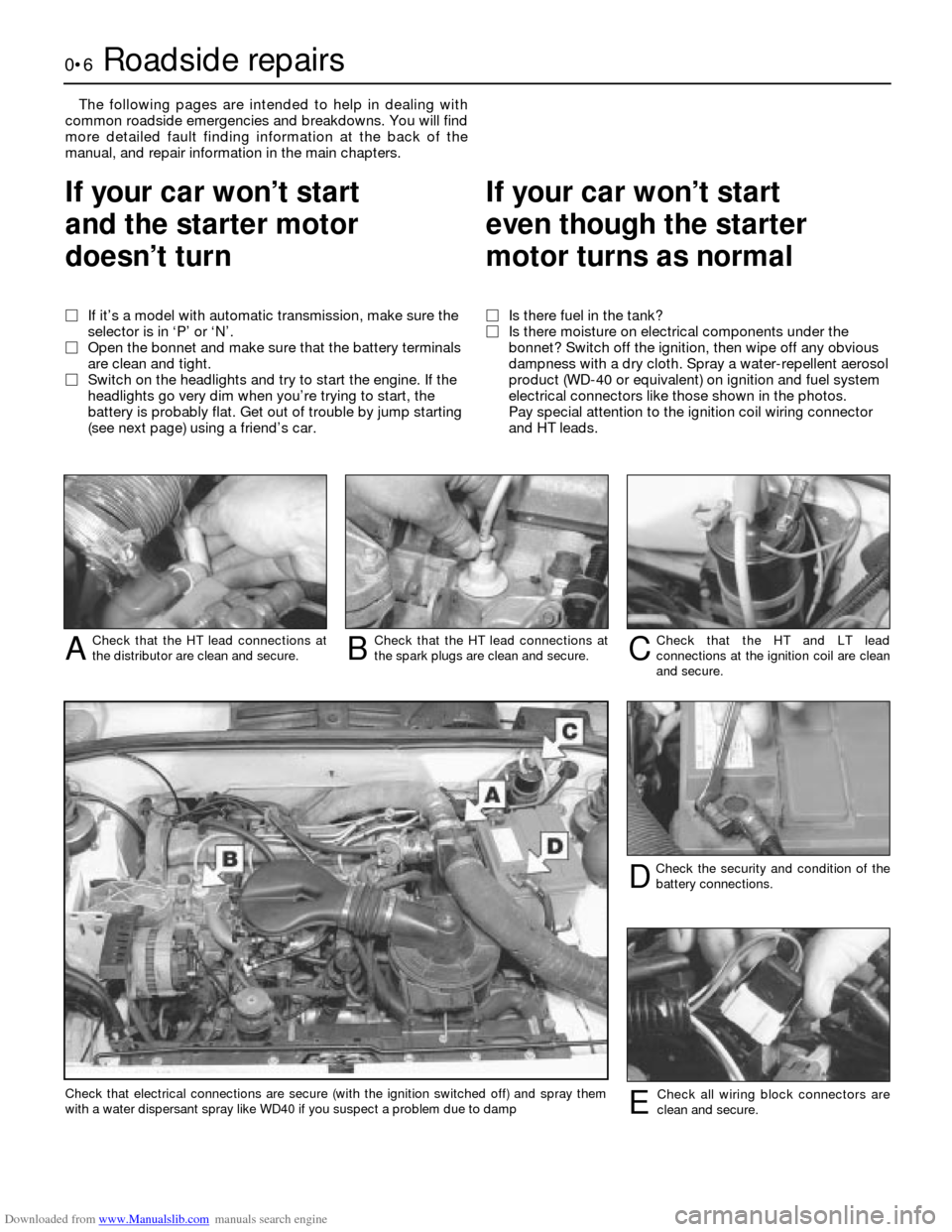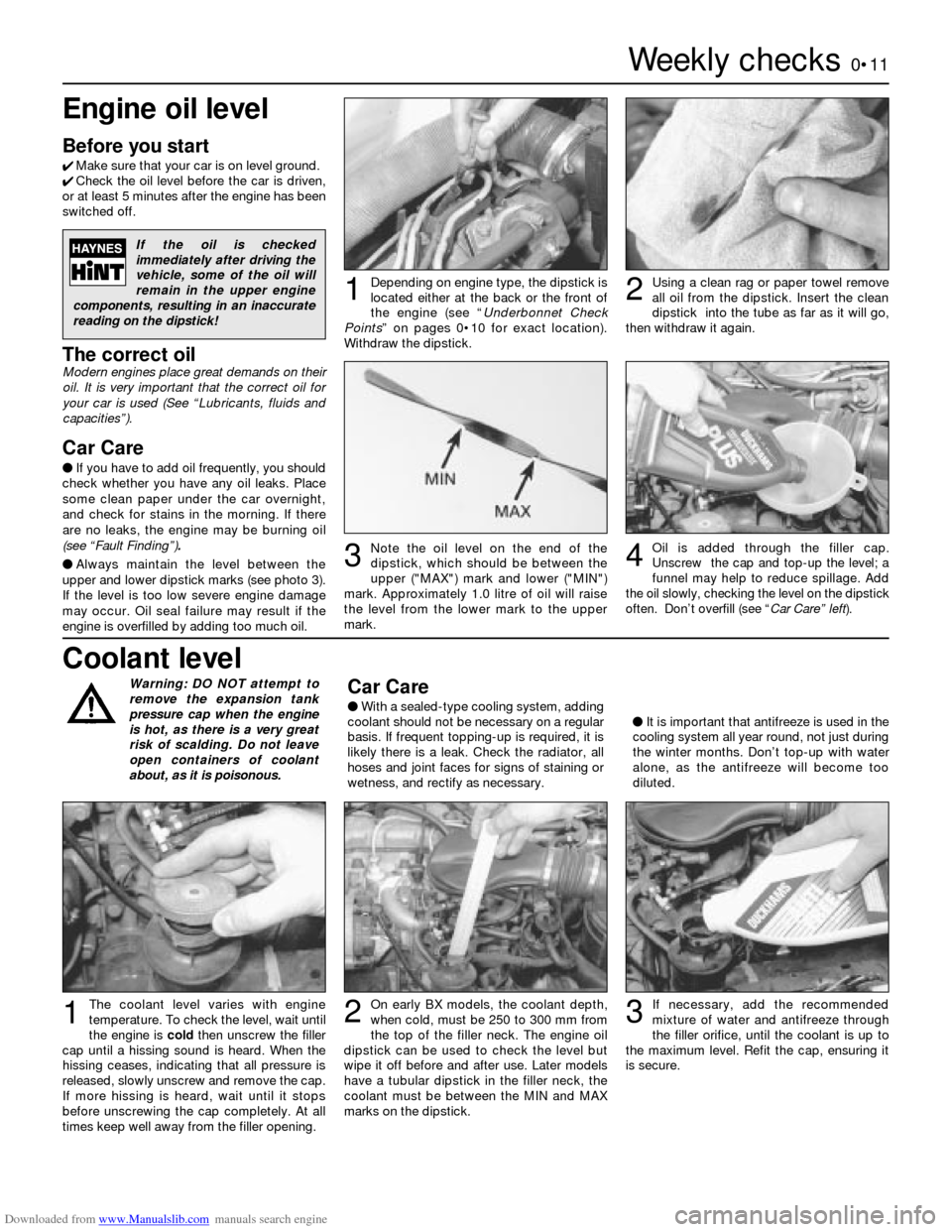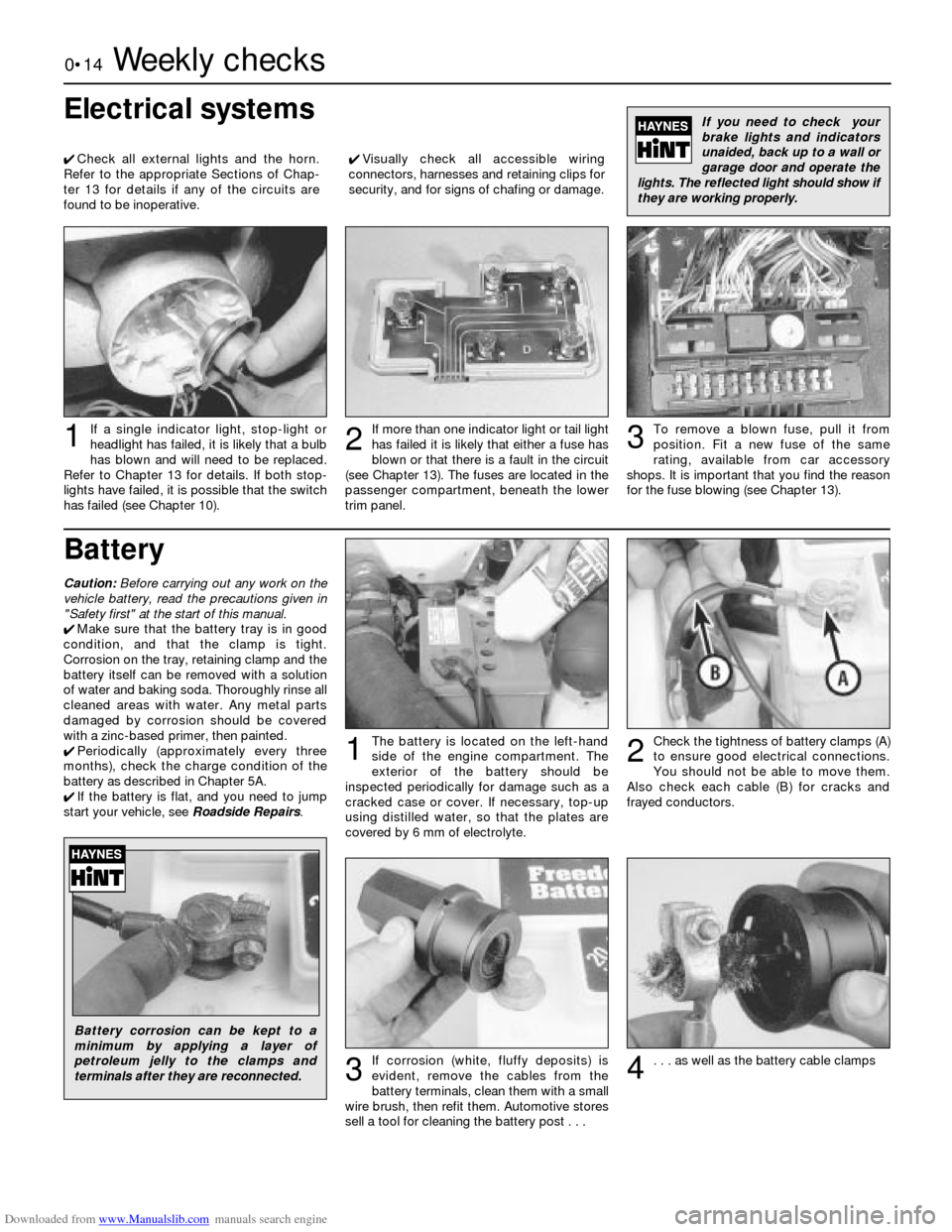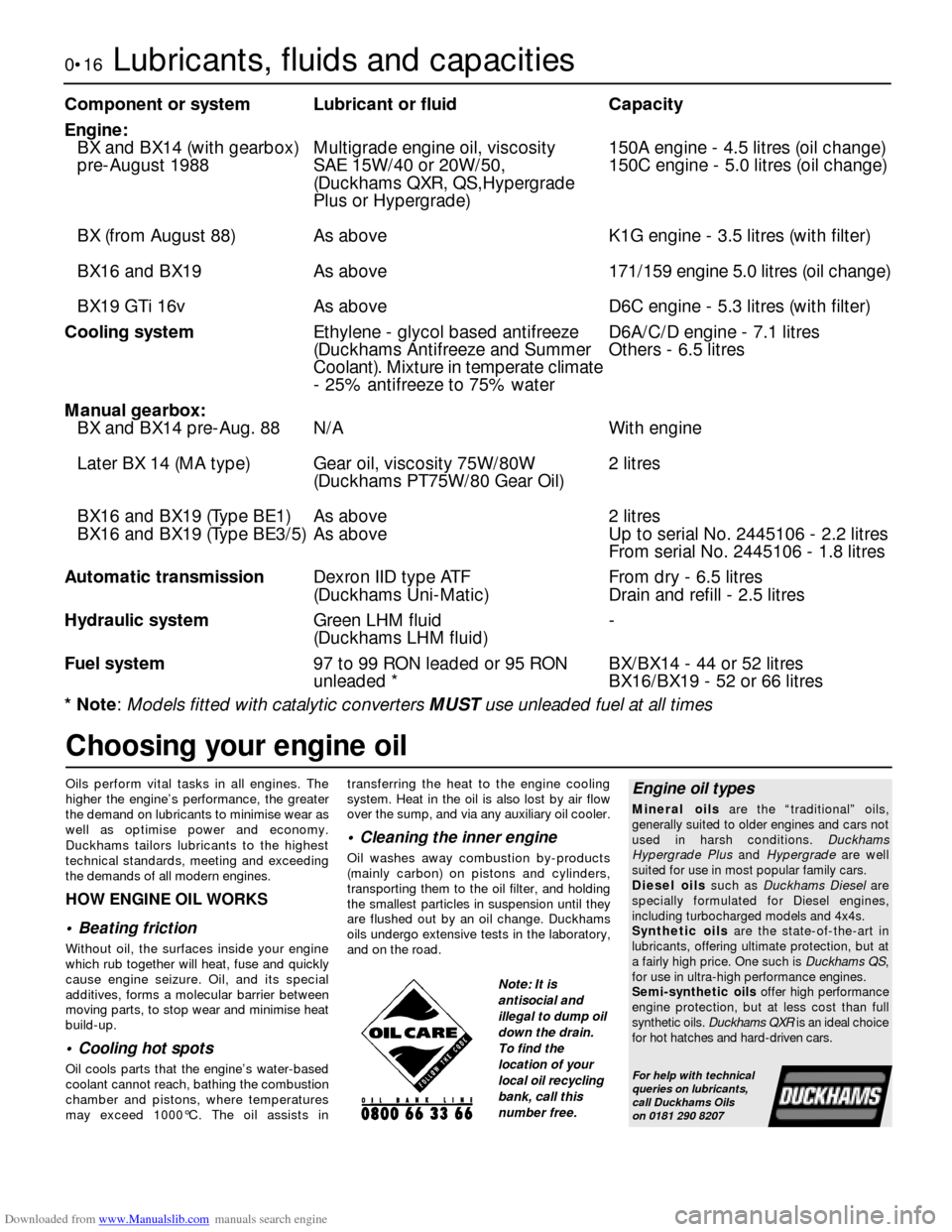ECU Citroen BX HATCHBACK 1992 2.G Workshop Manual
[x] Cancel search | Manufacturer: CITROEN, Model Year: 1992, Model line: BX HATCHBACK, Model: Citroen BX HATCHBACK 1992 2.GPages: 16, PDF Size: 0.47 MB
Page 6 of 16

Downloaded from www.Manualslib.com manuals search engine 0•6Roadside repairs
The following pages are intended to help in dealing with
common roadside emergencies and breakdowns. You will find
more detailed fault finding information at the back of the
manual, and repair information in the main chapters.
If your car won’t start
and the starter motor
doesn’t turn
MIf it’s a model with automatic transmission, make sure the
selector is in ‘P’ or ‘N’.
MOpen the bonnet and make sure that the battery terminals
are clean and tight.
MSwitch on the headlights and try to start the engine. If the
headlights go very dim when you’re trying to start, the
battery is probably flat. Get out of trouble by jump starting
(see next page) using a friend’s car.
If your car won’t start
even though the starter
motor turns as normal
MIs there fuel in the tank?
MIs there moisture on electrical components under the
bonnet? Switch off the ignition, then wipe off any obvious
dampness with a dry cloth. Spray a water-repellent aerosol
product (WD-40 or equivalent) on ignition and fuel system
electrical connectors like those shown in the photos.
Pay special attention to the ignition coil wiring connector
and HT leads.
Check that the HT lead connections at
the distributor are clean and secure.ACheck that the HT lead connections at
the spark plugs are clean and secure.BCheck that the HT and LT lead
connections at the ignition coil are clean
and secure.C
Check the security and condition of the
battery connections.D
Check all wiring block connectors are
clean and secure.ECheck that electrical connections are secure (with the ignition switched off) and spray them
with a water dispersant spray like WD40 if you suspect a problem due to damp
Page 11 of 16

Downloaded from www.Manualslib.com manuals search engine Weekly checks0•11
Engine oil level
Before you start
4Make sure that your car is on level ground.
4Check the oil level before the car is driven,
or at least 5 minutes after the engine has been
switched off.
The correct oilModern engines place great demands on their
oil. It is very important that the correct oil for
your car is used (See “Lubricants, fluids and
capacities”).
Car Care
l If you have to add oil frequently, you should
check whether you have any oil leaks. Place
some clean paper under the car overnight,
and check for stains in the morning. If there
are no leaks, the engine may be burning oil
(see “Fault Finding”).
lAlways maintain the level between the
upper and lower dipstick marks (see photo 3).
If the level is too low severe engine damage
may occur. Oil seal failure may result if the
engine is overfilled by adding too much oil.
If the oil is checked
immediately after driving the
vehicle, some of the oil will
remain in the upper engine
components, resulting in an inaccurate
reading on the dipstick!
Depending on engine type, the dipstick is
located either at the back or the front of
the engine (see “Underbonnet Check
Points” on pages 0•10 for exact location).
Withdraw the dipstick.Using a clean rag or paper towel remove
all oil from the dipstick. Insert the clean
dipstick into the tube as far as it will go,
then withdraw it again.
Note the oil level on the end of the
dipstick, which should be between the
upper ("MAX") mark and lower ("MIN")
mark. Approximately 1.0 litre of oil will raise
the level from the lower mark to the upper
mark.Oil is added through the filler cap.
Unscrew the cap and top-up the level; a
funnel may help to reduce spillage. Add
the oil slowly, checking the level on the dipstick
often. Don’t overfill (see “Car Care” left).
12
34
Warning: DO NOT attempt to
remove the expansion tank
pressure cap when the engine
is hot, as there is a very great
risk of scalding. Do not leave
open containers of coolant
about, as it is poisonous.Car Care
lWith a sealed-type cooling system, adding
coolant should not be necessary on a regular
basis. If frequent topping-up is required, it is
likely there is a leak. Check the radiator, all
hoses and joint faces for signs of staining or
wetness, and rectify as necessary.lIt is important that antifreeze is used in the
cooling system all year round, not just during
the winter months. Don’t top-up with water
alone, as the antifreeze will become too
diluted.
Coolant level
The coolant level varies with engine
temperature. To check the level, wait until
the engine is cold then unscrew the filler
cap until a hissing sound is heard. When the
hissing ceases, indicating that all pressure is
released, slowly unscrew and remove the cap.
If more hissing is heard, wait until it stops
before unscrewing the cap completely. At all
times keep well away from the filler opening.On early BX models, the coolant depth,
when cold, must be 250 to 300 mm from
the top of the filler neck. The engine oil
dipstick can be used to check the level but
wipe it off before and after use. Later models
have a tubular dipstick in the filler neck, the
coolant must be between the MIN and MAX
marks on the dipstick.If necessary, add the recommended
mixture of water and antifreeze through
the filler orifice, until the coolant is up to
the maximum level. Refit the cap, ensuring it
is secure.123
Page 14 of 16

Downloaded from www.Manualslib.com manuals search engine 0•14Weekly checks
Battery
Caution:Before carrying out any work on the
vehicle battery, read the precautions given in
"Safety first" at the start of this manual.
4Make sure that the battery tray is in good
condition, and that the clamp is tight.
Corrosion on the tray, retaining clamp and the
battery itself can be removed with a solution
of water and baking soda. Thoroughly rinse all
cleaned areas with water. Any metal parts
damaged by corrosion should be covered
with a zinc-based primer, then painted.
4Periodically (approximately every three
months), check the charge condition of the
battery as described in Chapter 5A.
4If the battery is flat, and you need to jump
start your vehicle, see Roadside Repairs.
The battery is located on the left-hand
side of the engine compartment. The
exterior of the battery should be
inspected periodically for damage such as a
cracked case or cover. If necessary, top-up
using distilled water, so that the plates are
covered by 6 mm of electrolyte.1Check the tightness of battery clamps (A)
to ensure good electrical connections.
You should not be able to move them.
Also check each cable (B) for cracks and
frayed conductors.2
Battery corrosion can be kept to a
minimum by applying a layer of
petroleum jelly to the clamps and
terminals after they are reconnected.
If corrosion (white, fluffy deposits) is
evident, remove the cables from the
battery terminals, clean them with a small
wire brush, then refit them. Automotive stores
sell a tool for cleaning the battery post . . .3. . . as well as the battery cable clamps4
Electrical systems
4Check all external lights and the horn.
Refer to the appropriate Sections of Chap-
ter 13 for details if any of the circuits are
found to be inoperative.4Visually check all accessible wiring
connectors, harnesses and retaining clips for
security, and for signs of chafing or damage.
If you need to check your
brake lights and indicators
unaided, back up to a wall or
garage door and operate the
lights. The reflected light should show if
they are working properly.
If a single indicator light, stop-light or
headlight has failed, it is likely that a bulb
has blown and will need to be replaced.
Refer to Chapter 13 for details. If both stop-
lights have failed, it is possible that the switch
has failed (see Chapter 10).If more than one indicator light or tail light
has failed it is likely that either a fuse has
blown or that there is a fault in the circuit
(see Chapter 13). The fuses are located in the
passenger compartment, beneath the lower
trim panel.
2
To remove a blown fuse, pull it from
position. Fit a new fuse of the same
rating, available from car accessory
shops. It is important that you find the reason
for the fuse blowing (see Chapter 13).31
Page 16 of 16

Downloaded from www.Manualslib.com manuals search engine 0•16Lubricants, fluids and capacities
Component or system Lubricant or fluid Capacity
Engine:
BX and BX14 (with gearbox) Multigrade engine oil, viscosity 150A engine - 4.5 litres (oil change)
pre-August 1988 SAE 15W/40 or 20W/50, 150C engine - 5.0 litres (oil change)
(Duckhams QXR, QS,Hypergrade
Plus or Hypergrade)
BX (from August 88) As above K1G engine - 3.5 litres (with filter)
BX16 and BX19 As above171/159 engine 5.0 litres (oil change)
BX19 GTi 16v As above D6C engine - 5.3 litres (with filter)
Cooling systemEthylene - glycol based antifreeze D6A/C/D engine - 7.1 litres
(Duckhams Antifreeze and Summer Others - 6.5 litres
Coolant). Mixture in temperate climate
- 25% antifreeze to 75% water
Manual gearbox:
BX and BX14 pre-Aug. 88 N/A With engine
Later BX 14 (MA type) Gear oil, viscosity 75W/80W 2 litres
(Duckhams PT75W/80 Gear Oil)
BX16 and BX19 (Type BE1) As above 2 litres
BX16 and BX19 (Type BE3/5) As above Up to serial No. 2445106 - 2.2 litres
From serial No. 2445106 - 1.8 litres
Automatic transmissionDexron IID type ATF From dry - 6.5 litres
(Duckhams Uni-Matic) Drain and refill - 2.5 litres
Hydraulic systemGreen LHM fluid -
(Duckhams LHM fluid)
Fuel system97 to 99 RON leaded or 95 RON BX/BX14 - 44 or 52 litres
unleaded * BX16/BX19 - 52 or 66 litres
* Note: Models fitted with catalytic converters MUSTuse unleaded fuel at all times
Oils perform vital tasks in all engines. The
higher the engine’s performance, the greater
the demand on lubricants to minimise wear as
well as optimise power and economy.
Duckhams tailors lubricants to the highest
technical standards, meeting and exceeding
the demands of all modern engines.
HOW ENGINE OIL WORKS
• Beating friction
Without oil, the surfaces inside your engine
which rub together will heat, fuse and quickly
cause engine seizure. Oil, and its special
additives, forms a molecular barrier between
moving parts, to stop wear and minimise heat
build-up.
• Cooling hot spots
Oil cools parts that the engine’s water-based
coolant cannot reach, bathing the combustion
chamber and pistons, where temperatures
may exceed 1000°C. The oil assists intransferring the heat to the engine cooling
system. Heat in the oil is also lost by air flow
over the sump, and via any auxiliary oil cooler.
• Cleaning the inner engine
Oil washes away combustion by-products
(mainly carbon) on pistons and cylinders,
transporting them to the oil filter, and holding
the smallest particles in suspension until they
are flushed out by an oil change. Duckhams
oils undergo extensive tests in the laboratory,
and on the road.
Engine oil types
Mineral oilsare the “traditional” oils,
generally suited to older engines and cars not
used in harsh conditions. Duckhams
Hypergrade Plus and Hypergradeare well
suited for use in most popular family cars.
Diesel oilssuch as Duckhams Dieselare
specially formulated for Diesel engines,
including turbocharged models and 4x4s.
Synthetic oilsare the state-of-the-art in
lubricants, offering ultimate protection, but at
a fairly high price. One such is Duckhams QS,
for use in ultra-high performance engines.
Semi-synthetic oilsoffer high performance
engine protection, but at less cost than full
synthetic oils. Duckhams QXRis an ideal choice
for hot hatches and hard-driven cars.
For help with technical
queries on lubricants,
call Duckhams Oils
on 0181 290 8207
Choosing your engine oil
Note: It is
antisocial and
illegal to dump oil
down the drain.
To find the
location of your
local oil recycling
bank, call this
number free.